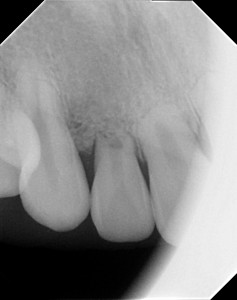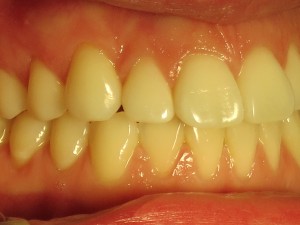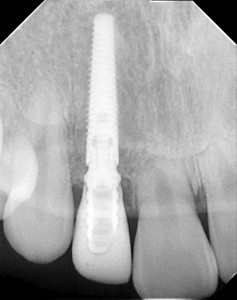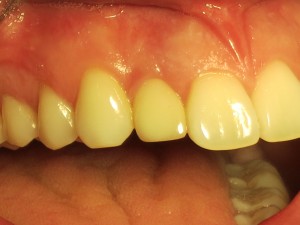Can you tell which tooth has extensive external resorption?
Recently it seems I am have many patients referred for implants to replace teeth that are deemed non-restorable due to root resorption. Many wonder what is root resorption and whether they there was something that initiated it or if there was a way to prevent. We are seeing this more and more of this, whether its genetics, the higher level of clinching of teeth due to stress or nocturnal bruxism, or the increase is acceptance of orthodontics / Invisalign in adult patients, or impacted canines that were not treated in a timely fashion…I suspect the number of these unique cases will increase with time.
In the most recent edition of the CDA (Ca Dental Assoc.) Journal, Dr. Aziz and his colleagues recently published a great summary article on this topic. Here is a small summary of the article. For full details please refer to the article itself. Root resorption is divided into two groups: External versus internal root resorption. Depending on the category, the prognosis and treatment is different in each instance.
The first and the most critical step in determining the prognosis and possible treatment is the need for a high quality CBCT (3D image) of the suspected tooth. This will determine whether there is external or internal resorption. If there is extensive external resorption +/- ankylosis (when the tooth becomes fused to the bone due to a loss of the periodontal ligament(PDL)), then there is not that can be done. However if the external resorption is infective in nature, then if the offending agent is removed in a timely a fashion the tooth can be saved. If internal resorption is noted, then the only way to save the tooth, is with a Root Canal Treatment (RCT) by a well-trained Endodontist. If the internal resorption is beyond the confines of the tooth itself, meaning if it has resorbed completely through the tooth and to the bone surrounding the tooth; then most endodontist recommend extraction at that point.
Here is a link to the actual article on page 15:
Happy reading!

With guided surgery and prefabricated temporary crown we were able to extraction the tooth, place an immediate implant with a crown. My students ask how? This is only accomplished using Guided surgery which combines, CBCT + 3D printing + iTero Scanning. Below is the picture of the replaced tooth with the implant + the prefab temp after 3 weeks. We suspect that the exposure and ligation of the canine at the later age lead to the resorption of all the neighboring teeth. So even though they were able to bring the canine into occlusion, it came at a cost to the other teeth.



